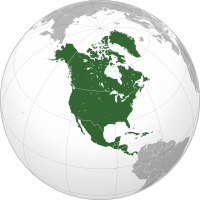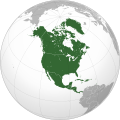
Back ܬܪܥܐ:ܐܡܪܝܩܐ ܓܪܒܝܝܬܐ ARC Партал:Паўночная Амэрыка BE-X-OLD دەروازە:ئەمریکای باکوور CKB Πύλη:Αμερική/Βόρεια Αμερική Greek Portalo:Nordameriko Esperanto Portal:América del Norte Spanish Teemasivu:Pohjois-Amerikka Finnish Portail:Amérique du Nord French प्रवेशद्वार:उत्तर अमेरिका Hindi Portal:Amerika Utara ID
The North America Portal

North America is a continent in the Northern and Western Hemispheres. North America is bordered to the north by the Arctic Ocean, to the east by the Atlantic Ocean, to the southeast by South America and the Caribbean Sea, and to the west and south by the Pacific Ocean. The region includes the Bahamas, Bermuda, Canada, the Caribbean, Central America, Clipperton Island, Greenland, Mexico, Saint Pierre and Miquelon, the Turks and Caicos Islands, and the United States.
North America covers an area of about 24,709,000 square kilometers (9,540,000 square miles), representing approximately 16.5% of the Earth's land area and 4.8% of its total surface area. It is the third-largest continent by size after Asia and Africa, and the fourth-largest continent by population after Asia, Africa, and Europe. As of 2021[update], North America's population was estimated as over 592 million people in 23 independent states, or about 7.5% of the world's population. In human geography, the terms "North America" and "North American" can refer to Canada, the United States, Mexico, and Greenland or, alternatively, Canada, Greenland and the US (Mexico being classified as part of Latin America) or simply Canada and the US (Greenland being classified as either Arctic or European (due to its political status as a part of Denmark) and Mexico classified as Latin American).
It is unknown with certainty how and when first human populations first reached North America. People were known to live in the Americas at least 20,000 years ago, but various evidence points to possibly earlier dates. The Paleo-Indian period in North America followed the Last Glacial Period, and lasted until about 10,000 years ago when the Archaic period began. The classic stage followed the Archaic period, and lasted from approximately the 6th to 13th centuries. Beginning in 1000 AD, the Norse were the first Europeans to begin exploring and ultimately colonizing areas of North America.
In 1492, the exploratory voyages of Christopher Columbus led to a transatlantic exchange, including migrations of European settlers during the Age of Discovery and the early modern period. Present-day cultural and ethnic patterns reflect interactions between European colonists, indigenous peoples, enslaved Africans, immigrants from Europe, Asia, and descendants of these respective groups. (Full article...)

The Oliver Typewriter Company was an American typewriter manufacturer headquartered in Chicago, Illinois. The Oliver Typewriter was one of the first "visible print" typewriters, meaning text was visible to the typist as it was entered. Oliver typewriters were marketed heavily for home use, using local distributors and sales on credit. Oliver produced more than one million machines between 1895 and 1928 and licensed its designs to several international firms.
Competitive pressure and financial troubles resulted in the company's liquidation in 1928. The company's assets were purchased by investors who formed The British Oliver Typewriter Company, which manufactured and licensed the machines until its own closure in the late 1950s. The last Oliver typewriter was produced in 1959. (Full article...)

Hillary Diane Rodham Clinton (née Rodham; born October 26, 1947) is an American politician and diplomat. She was the 67th United States secretary of state in the administration of Barack Obama from 2009 to 2013, a U.S. senator representing New York from 2001 to 2009, and the first lady of the United States as the wife of Bill Clinton from 1993 to 2001. A member of the Democratic Party, she was the party's nominee in the 2016 presidential election, becoming the first woman to win a presidential nomination by a major U.S. political party and the only woman to win the popular vote for U.S. president. She is the only first lady of the United States to have run for elected office.
Rodham graduated from Wellesley College in 1969 and from Yale Law School in 1973. After serving as a congressional legal counsel, she moved to Arkansas and, in 1975, married Bill Clinton. In 1977, Clinton co-founded Arkansas Advocates for Children and Families, and in 1979 she became the first woman partner at Little Rock's Rose Law Firm. Clinton was the first lady of Arkansas from 1979 to 1981 and again from 1983 to 1992. As the first lady of the U.S., Clinton advocated for healthcare reform. In 1994, her health care plan failed to gain approval from Congress. In 1997 and 1999, Clinton played a leading role in promoting the creation of the State Children's Health Insurance Program, the Adoption and Safe Families Act, and the Foster Care Independence Act. In 1998, Clinton's marital relationship came under public scrutiny during the Lewinsky scandal, which led her to issue a statement that reaffirmed her commitment to the marriage. (Full article...)

The Panamanian white-faced capuchin (Cebus imitator), also known as the Panamanian white-headed capuchin or Central American white-faced capuchin, is a medium-sized New World monkey of the family Cebidae, subfamily Cebinae. Native to the forests of Central America, the white-faced capuchin is important to rainforest ecology for its role in dispersing seeds and pollen.
Among the best known monkeys, the Panamanian white-faced capuchin is recognized as the typical companion to the organ grinder. In recent years the species has become popular in American media, particularly in the Pirates of the Caribbean film series. It is a highly intelligent monkey and has been trained to assist paraplegic persons. It is a medium-sized monkey, weighing up to 3.9 kg (8 lb 10 oz). It is mostly black, but with a pink face and white on much of the front part of the body, giving it its common name. It has a distinctive prehensile tail that is often carried coiled up and is used to help support the monkey when it is feeding beneath a branch. (Full article...)
Did you know...
- ...that the proposed Atlantica trade bloc would economically tie New England in the U.S. to the Atlantic Provinces of Canada?
- ...that a circumferentor (pictured) was an important tool to surveyors for mapping the North American frontier?
- ...that Pico Turquino in the Sierra Maestra mountains is the highest point in Cuba at 6,749 feet?
- ... that the First Mexican Empire was the official name of independent Mexico under a monarchical regime from 1822 to 1823?
- ... that the book The Complex: How the Military Invades Our Everyday Lives explores U.S. military expenditures on items including Southern catfish restaurants and Dunkin' Donuts?
Selected panorama

Topics
Categories
List articles
Related portals
Northern America
Central America
Caribbean
WikiProjects
 North America
North America-
 Canada
Canada -
 Greenland
Greenland -
 Mexico
Mexico -
 Saint Pierre and Miquelon
Saint Pierre and Miquelon -
 United States
United States  Central America
Central America-
 Belize
Belize -
 Costa Rica
Costa Rica -
 El Salvador
El Salvador -
 Guatemala
Guatemala -
 Honduras
Honduras -
 Nicaragua
Nicaragua -
 Panama
Panama  Mesoamerica
Mesoamerica Caribbean
Caribbean-
 Antigua and Barbuda
Antigua and Barbuda -
 Bahamas
Bahamas -
 Barbados
Barbados -
 Bermuda
Bermuda -
 Cuba
Cuba -
 Dominica
Dominica -
 Dominican Republic
Dominican Republic -
 Grenada
Grenada -
 Haiti
Haiti -
 Jamaica
Jamaica -
 Puerto Rico
Puerto Rico -
 Saint Kitts and Nevis
Saint Kitts and Nevis -
 Saint Lucia
Saint Lucia -
 Saint Vincent and the Grenadines
Saint Vincent and the Grenadines -
 Trinidad and Tobago
Trinidad and Tobago
Associated Wikimedia
The following Wikimedia Foundation sister projects provide more on this subject:
-
Commons
Free media repository -
Wikibooks
Free textbooks and manuals -
Wikidata
Free knowledge base -
Wikinews
Free-content news -
Wikiquote
Collection of quotations -
Wikisource
Free-content library -
Wikiversity
Free learning tools -
Wikivoyage
Free travel guide -
Wiktionary
Dictionary and thesaurus

























